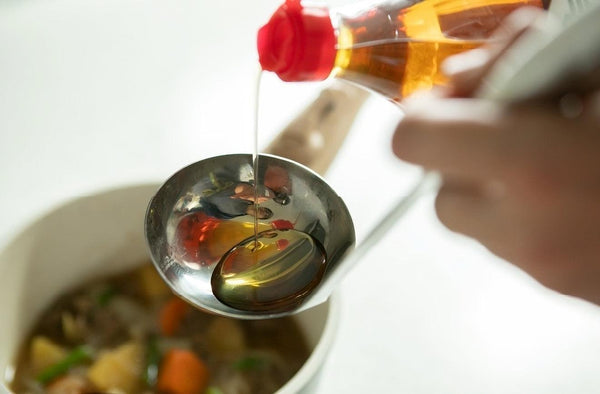
Jump to:
If you are interested in Japanese cooking, or Japanese food in general, you will have probably come across mirin before. As it lacks the general familiarity of condiments such as soy sauce, however, you may be unsure what it is or how, or even if, you should use it in your cooking. If that is you, this article has you covered.
In this blog post, we will take a deep dive into mirin, answering the questions: “What is mirin sauce?”, “What’s the history of mirin?”, and “What does mirin taste like?”. We shall also explore the different types of mirin rice wine, looking particularly at how Hon-mirin differs from other types. We will then look at how it is used in cooking, what substitutes can be used, where to buy it, and how to store mirin, before rounding off by looking at some major brands of mirin available on the Japanese Taste website.
What Is Mirin?

Mirin is a type of rice wine, used both as a seasoning in Japanese cooking and, less commonly, as a beverage in its own right. It is lower in alcohol and higher in sugar than sake, and also has a syrupy consistency not found in sake.
Mirin is made from glutinous rice, koji (rice malt), and shochu (brewing alcohol). When the steamed glutinous rice, koji, and shochu are brewed, the starch in the glutinous rice and koji itself is broken down into sugar by the amylase enzyme produced by the rice malt. A traditional production process is then used to further mature the pressed liquid and make mirin.
How Did It All Start?
While there are various theories on the origins of mirin sauce, there are two predominant ones. The first is that it was introduced from China during the so-called “Warring States Period” (approximately 1467-1615), when a sweet liquor called “蜜淋”(Mii-rin) was brought to Japan. The second is that shochu was added to the liquors known as Nerizake and white sake, which had both existed in Japan since ancient times, to prevent them from spoiling. During this period, mirin came to be particularly favored by women who did not favor strong alcohol. Then, in the Edo period (around 1603-1868), it started to be used as a seasoning, initially in sauces for broiled eel and soba noodles. From the Meiji period to the pre-war period, hon mirin (the different types are discussed below) was considered a luxury item, and in many cases, it was used only in Japanese restaurants. However, the revision to the Liquor Tax law in the 1950s led to a significant reduction in taxes, and this facilitated the use of hon mirin in ordinary households as well.
Different Types Of Mirin

Mirin, an essential ingredient in Japanese cuisine, can be categorized into several types, each with unique characteristics and uses. The two main types are hon-mirin and mirin-like seasonings.
Hon-mirin, also known as "true" mirin, is the most traditional form. Made from glutinous rice, koji, and shochu, hon-mirin has an alcohol content of around 14%, which contributes to its rich flavor and deep umami. This authentic version of mirin is prized for its ability to enhance the taste of dishes like teriyaki and sukiyaki, adding a balanced sweetness and complexity. It's also an important ingredient in some Japanese sweets, such as castella cake.
Mirin-like seasonings offer more affordable alternatives, including aji-mirin and shio-mirin. Aji-mirin is made from rice and koji, but the fermentation process is adjusted, resulting in a much lower alcohol content of around 1%. To achieve the sweetness similar to hon-mirin, aji-mirin often contains added sweeteners like corn-fructose syrup. While it mimics the flavor of hon-mirin, aji-mirin lacks the depth of umami and complexity, making it a more budget-friendly option for everyday cooking.
Shio-mirin is another variation where salt is added, typically containing about 1.5% salt. This version is non-drinkable, which allows it to be sold without the same taxes as alcoholic beverages. Shio-mirin has a similar flavor to aji-mirin but with a slight saltiness, affecting the sweetness balance in recipes.
Lastly, mirin-fu chomiryo, or "mirin-style seasoning," is the most economical option. It typically contains no alcohol or very minimal alcohol content, and its sweetness is derived entirely from added sugars. While it lacks the complexity of hon-mirin, it serves as a budget-friendly substitute for recipes where alcohol or deep umami flavor is not necessary.
How Is Mirin Used In Cooking?

Mirin is perfect for adding an additional layer of sweetness and umami to your cooking. Its high sugar content makes it ideal for use in glazes, marinades, and sauces. In fact, mirin is a commonly used ingredient in popular Japanese sauces such as teriyaki sauce (also see this article for how to make homemade teriyaki sauce using mirin) and ponzu sauce. It can also be partnered with soy sauce to make a brazing solution.
Mirin is often used in simmered dishes because it removes strong food odors, prevents the food from falling apart during the boiling process, and gives it a beautiful finish. It also adds "shine and luster" to dishes and allows the ingredients to soak up the umami, making the dish even more delicious.
Mirin is also used as a seasoning for noodles, such as soba, udon, and ramen, and a touch may be added as the last ingredient in miso soup to give it an additional sweetness.
Where Can I Buy Mirin?
A large selection of mirin is available for purchase at most Japanese supermarkets and grocery stores. As mentioned earlier, you should make sure you are aware of the difference between hon-mirin and mirin-like seasonings and alcohol content and price will normally be a fair indicator of this if you are unable to read the bottle. This page on the Japanese taste website is a great place to start your mirin journey.
Substitutes For Mirin
So, what do you do if a recipe calls for mirin, but you are caught short in the kitchen? Although you will not be able to achieve exactly the same taste, you may be able to achieve something similar by using dry sherry or Shaoxing cooking wine as a substitute for mirin. Of course, it is very possible that you will not have these either, so if you get really stuck, then mixing sugar and sake will get you a reasonable mirin substitute. You can also mix sugar with soy sauce to give both additional sweetness and umami to your dish. If you are using these for the first time, however, we would recommend adding them gradually so you can accurately gauge their effect on the flavor of your dish before you fully commit.
How To Store Mirin
So, once you have bought some mirin, what is the best way to store It to make sure you get the most out of your purchase?
As hon-mirin contains a fair amount of alcohol, it is recommended to store it at room temperature in a cool, dark place even after opening the package. It has been found that storing hon-mirin in a refrigerator may cause the sugar contained therein to crystallize and should be avoided.
Mirin-like seasoning, on the other hand, contains less than 1% alcohol and therefore will spoil more easily. It is recommended, therefore, that it be stored in a refrigerator after opening the package unless you plan to use it up quickly.
Ideally, both hon-mirin and mirin-like seasoning used in the above ways should be consumed within three months of opening.
Mirin vs Soy Sauce

Once you have decided that you want to try using mirin in your cooking, you should be aware of how it differs from some of the other seasonings available.
Probably the most well-known condiment in the Japanese kitchen is soy sauce or shoyu. There are two main types of shoyu. Koikuchi shoyu differs from mirin in that it has a strong taste that dominates the flavor of the food in which it is used. Usukuchi shoyu, on the other hand, like mirin, is used to enhance the natural flavors of the ingredients. However, it is much saltier and much less sweet than mirin, so gives food a completely different emphasis.
Mirin Vs Sake
Cooking sake is another popular condiment used in Japanese cuisine. Cooking sake contains higher levels of alcohol and is less sweet than mirin. You can find a great article explaining the differences between cooking sake and mirin here.
Mirin Vs Rice Vinegar
Rice vinegar is another staple of the Japanese pantry. Lacking the sweetness of mirin and providing a more bitter taste, it is used in a very different way to mirin in cooking. Check out the explanation of these differences in this article.
Does Mirin Need To Be Refrigerated?
Mirin rice wine is a condiment you may not use every day, so you need to ensure you store it correctly so that it will last as long as you need it to.
As we mentioned earlier, there are essentially three different types of mirin sauce - hon mirin, shio mirin, and mirin-style seasoning - and as such there are three different ways of storing mirin.
- Hon mirin: Hon mirin contains a lot of alcohol and sugar, so it can be stored at room temperature, in a cool, dark place such as a cupboard or pantry.
- Shio mirin: This type of aji mirin contains less alcohol than hon mirin, but they contain a lot of salt, so they can also be stored at room temperature after opening.
- Mirin-style seasoning: Shin mirin differs from the other two, as it contains almost no alcohol, so it must be stored in the refrigerator after opening.
The Best Japanese Mirin Brands
When it comes to mirin, there are some notable brands that pride themselves on making products that are good enough to drink in their own right and concentrate on providing high quality using traditional methods. If you want to know where to buy mirin, we would recommend checking out the following important brands available from the Japanese Taste website.
Sugiura

Hailing from Hekinan City in Aichi Prefecture, Sugiura have been making natural-brewed, long-aged products using traditional methods since 1924. Its mirin is made from carefully selected domestic glutinous rice, malted rice, and sake lees from nearby sake breweries, in an environment blessed with a climate suitable for mirin production and the excellent water quality of the Yahagi River. You can find their products here.
Yoneda

The Yoneda Sake Brewery, from Matsue City in Shimane Prefecture, makes hon-mirin using its own brewed shochu. Its traditional method uses carefully selected glutinous rice from Shimane Prefecture and rice koji, which is suitable for sake brewing, mixed with rice husks and sake lees and is distilled under normal pressure. It is packed raw, without heat treatment, in order to preserve its natural flavor. We really love this artisanal 1 year-aged mirin from Yoneda.
Fukumitsuya

Fukumitsuysa, from Kanazawa City, make their hon-mirin only from glutinous rice grown in Ishikawa Prefecture and rice malt made exclusively from Fukunohana, a type of rice cultivated specifically for sake brewing. It is composed of a natural sweetness and umami, and is characterized by its elegant, deep, and mellow flavor. Why not check out their excellent hon-mirin, which is aged for 3 years?
Gyokusen

Yorochu in Gifu, where the Gyokusendo Sake Brewery has been brewing sake for over 200 years, is home to the Yoro Falls and is a town famous for the high quality of its water. Its “Junmai mirin” uses only 100% domestic-produced glutinous rice, rice malt, and homemade shochu as its raw materials, and the brewery uses traditional methods without adding any sugars or amino acids. Its long aging process brings out a soft flavor and elegant mellowness. You can try Gyokusen mirin here.
Interested in learning more about the best Japanese mirin on the market? Be sure to check out this article where we introduce the top 6 mirin sauces you can buy from Japan.
Mirin - The Multi-Purpose Japanese Condiment

As discussed, mirin is not only a commonly used seasoning added to Japanese cooking, but it also forms the basis of some of the most popular sauces, such as teriyaki or ponzu sauce. It can also be enjoyed as a lighter alcoholic beverage, but please make sure you are drinking hon-mirin rather than mirin-flavored seasoning. If you are taking the trouble to drink it as a beverage, we would also recommend drinking one of the longer-aged mirin products discussed in the previous section.
What is your favorite way of using mirin? Please let us know in the comments.


0 comments